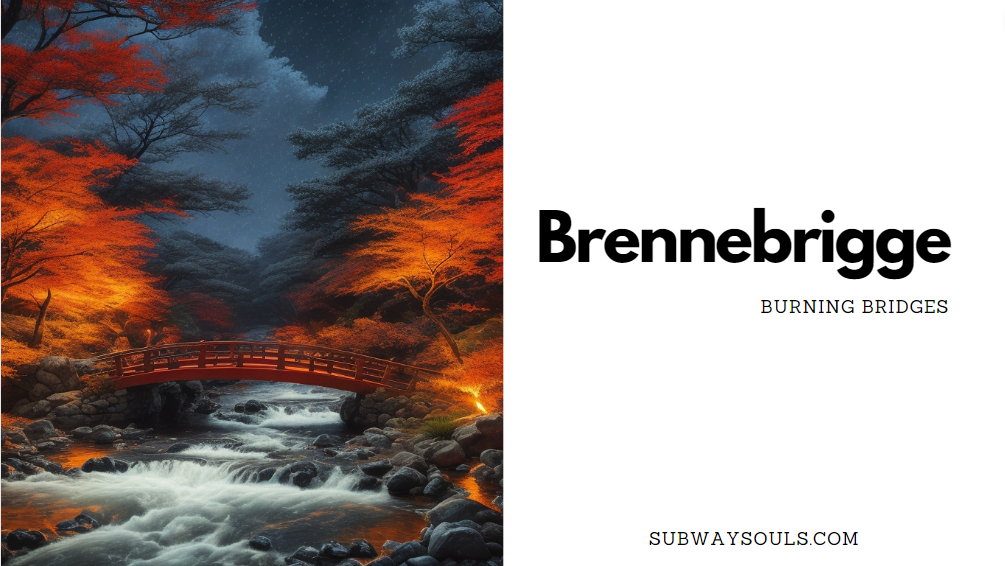Crossing that burning bridge .
In the intricate tapestry of England’s geography, certain places – towns, villages and hamlets – bear names that echo the rich history of diverse human connectivity.
Among these, a fascinating category stands out—towns and cities named after bridges.
As symbols of both practicality and metaphorical connection, bridges have played a crucial role in shaping the cultural and physical landscape of England.
Some are obvious. Cambridge the world famous University town being one of those. Once you know that Cambridge grew up on the River Cam, then its etymology seems pretty obvious, a bridge over the river Cam.
It’s not quite that simple, though. The river was originally known as the Granta (still is in some sections), and the town as Grantabrycge, named under Danish rule.
Over time, this got twisted to the modern Cambridge, and the river name changed to match. So in essence the bridge and river morphed over time, probably into more comfortable phrasing for the majority native speakers. Maybe.
That part is guess work on the authors part.
Facts sprinkled with fiction.
Edenbridge is a town and civil parish in the Sevenoaks district of Kent, England. In England, a civil parish is a unit of local government. Civil parishes are the lowest tier of local government, below districts and counties. It is an administrative parish, in comparison to an ecclesiastical (church) parish.
The name Edenbridge derives from Old English Eadhelmsbrigge (brigge meaning bridge, together meaning “Eadhelm’s Bridge”). It is located on the border of Kent and Surrey, on the upper floodplain of the River Medway and takes its name from that river’s tributary, the River Eden. Language developed based on location, yet the basis being a place where a bridge was needed to cross the river.
Some meanings go a little beyond location based naming. Maybe only a little, but enough to add a basic historical context. For example with Ivybridge in South Devon. The origin is exactly as you are imagining in your head right now before I even type another word. Ivy + Bridge.
The town name of Ivybridge is derived from a small 13th century hump-backed bridge of the same name. The Ivy Bridge was the only means of crossing the fast flowing River Erme, which powered Ivybridge’s mills. “Ivy” was used to describe the bridge, because there was ivy growing along the bridge. Surrounded by beautiful countryside and moorland, Ivybridge has a magnificent natural setting and a rich heritage of traditional South Devon industries such as milling and cloth making.
And across England there are many other examples of towns named after bridges which had such basic yet natural inspirations. Pateley Bridge being one.
The name Pateley was first recorded 1175 as Patleiagate, with Pateley coming from the Old English meaning “woodland clearing of the paths”, referring to paths up the Nidderdale and to Craven which intersected here. The origin of the name is unclear, but it may refer to a clearing, or a shallow place by a ford. An old tradition suggests that ‘Pateley’ comes from the Yorkshire expression for a badger, but this notion has long been discredited.
Similarly, the name Stalybridge derives from ‘Staef’ – a stave – and ‘leah’ – a clearing in the wood, the full meaning of ‘Staley’ being ‘a wood where staves are collected’. The ‘bridge’ was added in the early 19th century. Prior to 1750, the population of Stalybridge was sparse. The bridge helped connect regions to develop the population.
There are many traditions associated with the name Cowbridge in Wales, one of which is, believe it or not, related to a bridge and a cow. The cow, being driven by dogs, took shelter under one of the arches. Her horns became so much entangled that she could not be taken out alive. The coat of arms of the town still show the figure of a cow on a bridge. I did actually research this. I know it appears that I have made invented this story, my seasoning of fiction, but it really is out there as happening. The town is first recorded as Pontyfon, (with mon or fon meaning cow in Old Welsh), and as Pontyfuwch (bridge of the cow in modern Welsh) by 1645. The modern Welsh name, Y Bont-faen, translates as ‘the stone bridge’. The English name is a direct translation of the older Welsh name of the town. Good job they didn’t have dragons chasing dinosaurs over the bridge. That’s a bridge name with mouthful of vowels no one outside of Wales would be able to pronounce.
Of course it wouldn’t be England if we didn’t seek out some bridge related romance attached to Royal history. That chocolate box image of Royal horse and carriages trotting over small brick bridges into their Royal estates, to shoot grouse and guffaw on pleasant lawns.
Kingsbridge takes its name from an ancient bridge that was built to link two Royal estates. By 1219 it was a market town and by the 18th century, milling was a major source of revenue for the town. The town formed around a bridge which was built in or before the 10th century between the Royal estates of Alvington, to the west, and Chillington, to the east, hence giving it the name of Kyngysbrygge (“King’s bridge”).
Royal Tunbridge Wells is a town recorded in the Domesday Book 1087 as Tonebrige, which may indicate a bridge belonging to the estate or manor (from the Old English tun), or alternatively a bridge belonging to Tunna, a common Anglo-Saxon man’s name. The prefix “Royal” dates to 1909, when King Edward VII granted the town its official “Royal” title to celebrate its popularity over the years among members of the royal family.
And so to neatly follow on from the subject of Royal bridges we arrive at crazy fiction; Trolls under bridges. Of course I am adding this ‘section’ because of my love for sprinkling and seasoning fact with fiction. Of course who is to say if Trolls are fact or fiction. One persons this, is another persons that.
Trolls, allegedly, with their empathy toward stone, are believed to be naturally drawn to stone bridges. It is thought – imagined – faked – yet hilarious – that Trolls become a part of the bridge itself, supporting the structure and making it safe for those who cross it. A bridge would often have a resident troll tucked away under its arch, lending strength to the structure. And charging you to cross, or only allowing pass if you answer a weird question. Is this where ‘tolls’ came from? Should I accept this as fact in my imagination?
The troll in the story of “The Three Billy Goats Gruff” threatens to eat the goats that cross the bridge he lives under. The fairy tale might as well be the reason why trolls are often portrayed as obstacles in bridges, since it was between the first introductions of these beings to the British mass public.
The first version of the story in English appeared in George Webbe Dasent’s translation of some of the Norske Folkeeventyr, published as Popular Tales from the Norse in 1859. The heroes of the tale are three male goats who need to outsmart a handsome troll named Phalanx to cross the bridge to their feeding ground.
I personally like the addition here of the Troll breaking stereotypes and being a smart and handsome troll. Personally any troll I would ever create in a story would dribble and put you off having your own children.
Anyway all this talk of fake furry goat murdering Trolls is distracting us from the main reason for this article….
Brennebrigge.
The town which houses the world behind the blue door.
333 That Street, Brennebrigge.
Of course this town would have an origin too. Of course it would have significance too. Of course its origin and meaning would answer some questions and yet raise many more. Of course the facts are tiny in comparison to the fiction. Not so much a sprinkling as a blanketing.
The rich Nordic history of this middle England region is remembered with the tales of a bridge that would be ceremonially burned. Some say to cut off access and others say symbolic of the cutting off those worshipping false idols. To Burn One’s Bridges.
To literally burn one’s bridges or boats likely has its origins in military campaign manoeuvres. It is said the great Caesar commanded his legions to burn the bridges behind him after crossing the Rubicon in 49 B.C. (another idiomatic term used today to declare there is no turning back).
The term “burning bridges” has origins dating back to the 1800s. It refers to a popular and well known military practice, also said to have been used in Roman warfare. The idea was to burn bridges over rivers to stop the enemy from advancing any further.
In this instance, in this region, in this era, in this vibrating recollection; the ‘burning of bridges’ modern day connotation is the leaving behind of indoctrination and false idols, whatever they represent and however they may manifest.
333 That Street. Brennebrigge.
It’s an address which speaks for itself.
Share this post: on Twitter on Facebook

